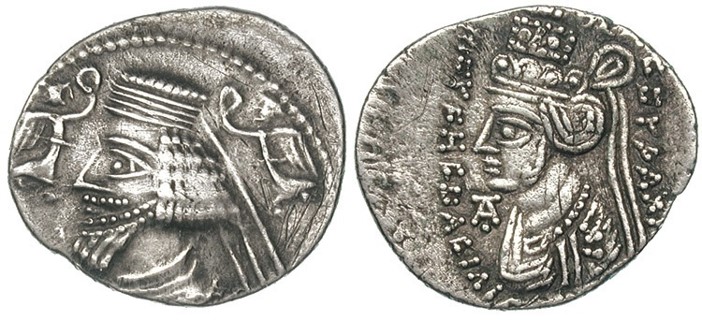2 BCE - 4 CE | ΘΕΑC OYPANIAC MOYCHC BACIΛΙCCHC
Overstriking coin
Phraataces_and_musa_Triton_III, _30_November–1_Dec._1999, _673.jpg
[1]
|
|
Sale(s)Sale(s) ᵖ:
|
Triton, III, 30 Nov.-1 Dec. 1999, 673 = Manhattan, 1, 5 Jan. 2010, 116
|
| Private collection(s)Private collection(s) ᵖ:
|
A. Lynn Collection
|
|
Description
| ObverseInscription or printing placed on the obverse.:
|
Diademed, jacketed bust of king left, wearing torque, crowned from front and back by two wreath-bearing Nikai
|
ReverseInscription or printing placed on the reverse.:
|
ΘΕΑC OYPANIAC MOYCHC BACIΛΙCCHC (Greek) diademed, draped bust of Musa, wearing tall crown, AT monogram below chin
|
Mint and issuing power
Chronology
| FromIdentifies the initial date in a range assigned in a numismatic context. 2 BCE toIdentifies the final date in a range assigned in a numismatic context.. 4 CE
|
Roman from 30 BC  periodTime period of the numismatic object. periodTime period of the numismatic object.
|
Physical description
MetalThe physical material (usually metal) from which an object is made.: Silver 
|
WeightWeight of the numismatic object (in grams). in grams: 3.843.84 g <br />3,840 mg <br />
|
DenominationTerm indicating the value of a numismatic object. Examples: tetradrachm, chalkous, denarius.: drachma 
|
|
|
|
|
References
Description
| ObverseInscription or printing placed on the obverse.:
|
|
ReverseInscription or printing placed on the reverse.:
|
|
Mint and issuing power
| MintIdentifies the place of manufacture or issue of a numismatic object. ᵖ:
|
|
Ancient regionAncient region. ᵖ
|
|
Modern countryModern country:
|
AuthorityIdentifies the authority in whose name (explicitly or implicitly) a numismatic object was issued. ᵖ:
|
|
Chronology
| FromIdentifies the initial date in a range assigned in a numismatic context. toIdentifies the final date in a range assigned in a numismatic context..
|
periodTime period of the numismatic object.
|
Physical description
References
| Frequency of overstrikesFrequency of overstrikes:
|
exceptional
|
Level of confidenceLevel of confidence of the identification:
|
|
| RemarksRemarks:
|
"Overstruck, perhaps on a Roman denarius": certainly not; looks as struck on a coin of the same type (but not a double strike)
|
References
- ^ Sellwood, David (1980), An introduction to the coinage of Parthia, 2nd ed., London, Spink & Son, 322 p., 10 pl.
- ^ Shore, Fred B. (1993), Parthian coins & history : ten dragons against Rome, Classical Numismatic Group, p.188
- ^ Fröhlich, Christine (2008), Monnaies indo-scythes et indo-parthes du Département des monnaies, médailles et antiques : catalogue raisonné, Bibliothèque nationale de France, p.158, pl.29

